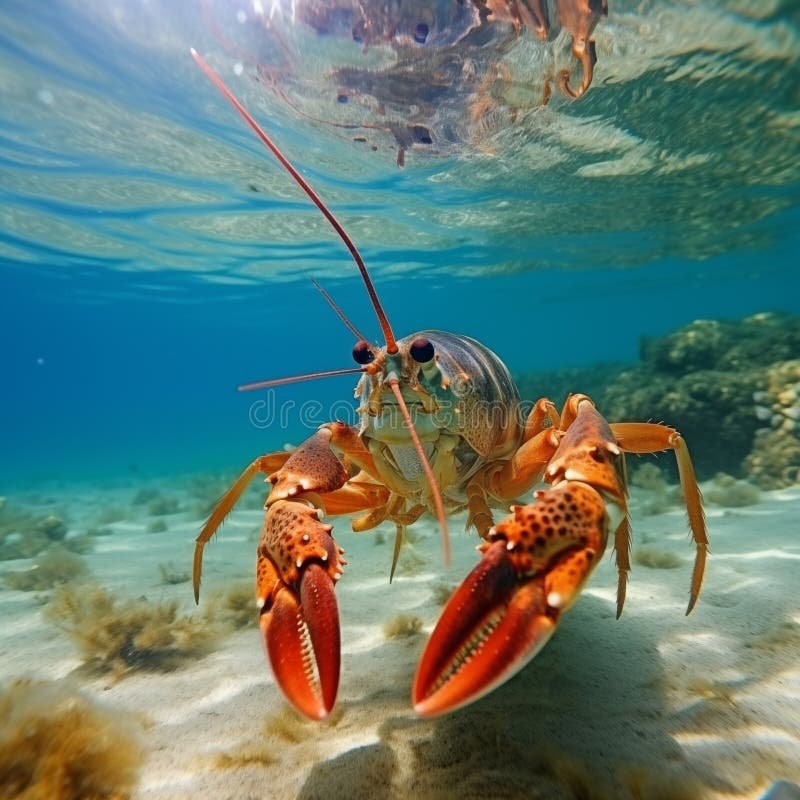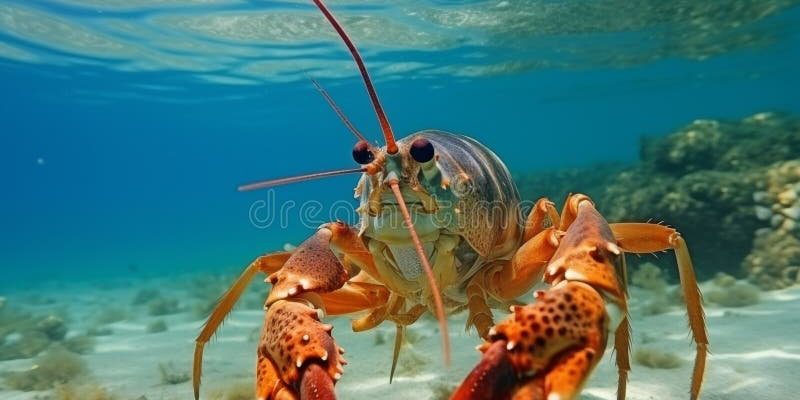
Lobsters are crustaceans that live in a world full of predators, shifting sands, and ever-changing temperatures. To navigate these underwater obstacles, they’ve developed some amazing adaptations. Let’s dive into the traits that allow lobsters to flourish beneath the waves and explore how their anatomy and behavior gives them the upper hand in the ocean’s depths.
1. Hard Exoskeleton for Protection
One of the most striking features of lobsters is their tough exoskeleton, which acts as a shield against predators. Think of it as a lobster’s suit of armor. This exoskeleton is made of chitin, a flexible yet durable material. It not only protects lobsters but also provides structural support for their bodies.
However, this armor comes with a catch: it doesn’t grow. So, lobsters must undergo a process called molting, where they shed their old exoskeleton to make way for a larger one. You might be wondering why they go through such a process. Well, it allows the lobster to grow and regenerate lost limbs! It’s like having a built-in ability to hit the reset button on their body.
During this molting process, lobsters are vulnerable. They often seek refuge in crevices or under rocks until their new shell hardens. This adaptation helps them survive in an environment where larger fish and other predators are always on the lookout for a meal.
2. Powerful Claws for Defense and Feeding
Lobsters have two distinct claws: a large one, known as the “crusher,” and a smaller one called the “pincer.” These claws serve multiple purposes, making them versatile tools for survival. The larger claw is powerful enough to crush the shells of prey, while the smaller claw is used for delicate tasks, like picking at food.
This division of labor is critical for their feeding habits. Lobsters are omnivores, meaning they eat both plants and animals. Their strong claws help them pry open shellfish or tear apart decaying organic matter on the ocean floor. In a way, lobsters are the clean-up crew of the sea, helping maintain a balanced ecosystem.
When threatened, lobsters can use their claws as weapons. A quick snap can send a clear message to potential predators: “Back off!” This ability to both defend and feed is essential for their survival in the wild.
3. Adaptable Coloration
The color of a lobster’s shell can vary widely, ranging from deep blue to bright red. This coloration isn’t just for looks; it plays a significant role in their survival. Lobsters rely on their color to blend into their surroundings, making it harder for predators to spot them.
For example, a lobster living among rocky substrates may develop darker hues to camouflage itself against the ocean floor. This blending ability allows them to sneak around, hunting for food while avoiding becoming someone else’s dinner.
Interestingly, lobsters can change color depending on their environment and the light conditions around them. Here’s the thing: changing colors isn’t just about hiding; it also helps lobsters communicate. Some colors might attract mates or signal aggression. It’s all about adapting to their social and physical environment.
4. Sensory Antennae for Navigation
Lobsters are equipped with long sensory antennae that are crucial for navigation and detecting food. These antennae are like their GPS, helping them sense their environment and find their way around the ocean floor. Imagine walking in a dark room; you’d naturally reach out to feel your surroundings. Lobsters do just that with their antennae!
These sensory organs are packed with receptors that pick up chemical signals in the water, allowing lobsters to detect food sources even from a distance. This ability is especially helpful in murky waters where visibility is low.
You might also be surprised to learn that lobsters have a keen sense of taste and smell. They can taste their food through their antennae, giving them the advantage of assessing potential meals before making a move. This fine-tuned sensitivity helps them stay well-fed and safe from danger.
5. Regenerative Abilities
One of the most remarkable adaptations of lobsters is their ability to regenerate lost limbs. If a lobster loses a claw due to a predator attack or during a fight, it can grow a new one. This process can take several weeks to months, depending on the lobster’s age and health.
Why is this ability significant? Well, losing a limb can be detrimental to a lobster’s survival, especially when it comes to feeding and defending itself. By being able to regrow a claw, lobsters reduce the risk of starvation and enhance their chances of mating.
Regeneration isn’t just limited to claws. Lobsters can also regrow antennae and legs. This extraordinary skill is a fascinating aspect of their biology, emphasizing the resilience and adaptability of these creatures in the wild.
6. Unique Reproductive Strategies
Lobster reproduction involves some interesting adaptations that ensure the survival of their species. Female lobsters carry their fertilized eggs on their abdomens for several months until they hatch. This protective strategy keeps the eggs safe from predators in the open water.
Once the eggs hatch, baby lobsters, or larvae, are released into the ocean. At first, they are tiny and vulnerable, drifting with ocean currents. To increase their chances of survival, they go through several stages of development, changing their appearance and behavior as they grow.
Honestly, lobsters have a unique way of ensuring their young have the best chance at life. They don’t just drop the eggs and run; they take an active role in protecting their offspring until they are ready to fend for themselves. This nurturing behavior highlights their commitment to the next generation.
7. Thriving in Diverse Habitats
Lobsters are adaptable creatures that can thrive in various underwater environments, from rocky bottoms to sandy shores. This adaptability allows them to occupy different niches within marine ecosystems. By finding shelter in holes or crevices, they can avoid predators and create a safe space to live and breed.
Their ability to tolerate different water conditions is also impressive. Lobsters can live in both deep and shallow waters, and they can withstand changes in temperature and salinity. This versatility ensures that they can make a home in various locations, from coastal regions to deeper ocean waters.
You might find it fascinating that lobsters often travel significant distances in search of food or breeding grounds. Their ability to navigate varied environments is a testament to their resilience and adaptability—key traits for thriving in the ocean.
In conclusion, lobsters are remarkable creatures that have evolved numerous adaptations to survive in their underwater world. From their hard exoskeleton and powerful claws to their sensory antennae and regenerative abilities, each trait helps them navigate the challenges of ocean life. As we explore more about these fascinating animals, we gain a deeper appreciation for the incredible ways life adapts to its surroundings. So, the next time you see a lobster, remember that there’s so much more beneath the surface than what meets the eye!

